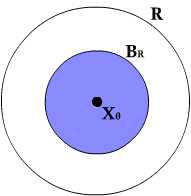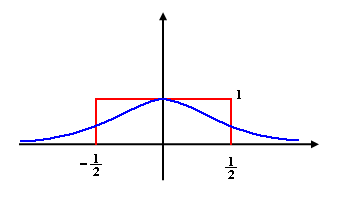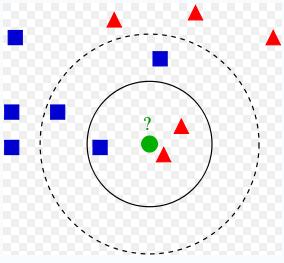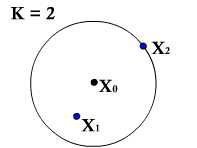Contents
[hide]Lecture 16, ECE662: Decision Theory
Lecture notes for ECE662 Spring 2008, Prof. Boutin.
Other lectures: 1, 2, 3, 4, 5, 6, 7, 8, 9, 10, 11, 12, 13, 14, 15, 16, 17, 18, 19, 20, 21, 22, 23, 24, 25, 26, 27, 28,
Parzen Window Method and K-Nearest Neighbor Density Estimate -continued
Example of a useful Parzen window function $ \in \mathbb{R}^n $
This function has zero mean, H variance, an n-dimensional density, and is not compactly supported.
You can use any $ \varphi $ such that:
1) $ \varphi(\vec{u})>0,\forall\vec{u} $
2) $ \int_{R^n}\varphi(\vec{u})d\vec{u}=1 $
Given i samples $ \vec{X}_1,\vec{X}_2,...,\vec{X}_i\in{R}^n $,
$ P_i(\vec{X}_0)=\frac{1}{i\cdot{V}_i}\displaystyle\sum_{l=1}^{i} \varphi(\frac{ \vec{X_l}-\vec{X_0} }{h_i} ) $, where $ h_i $ is a number that controls $ V_i $.
i.e. $ V_i=h_i^n $ since $ V_i=\int\varphi(\frac{\vec{u}}{h_i})d\vec{u} $
Letting $ \vec{v}=\frac{\vec{u}}{h_i} $ and $ d\vec{v}=\frac{1}{h_i^n}d\vec{u} $, we have:
$ tex: V_i=\int{h_i^n}\varphi(\vec{v})d\vec{v}=h_i^n\int_{R^n}\varphi(\vec{v})d\vec{v}=h_i^n $
$ p_1(\vec{X}_0)=\frac{1}{i\cdot{h_i^n}}\displaystyle\sum_{l=1}^{i}\varphi(\frac{\vec{X}_l-\vec{X}_0}{h_i}) $ For convergence (in mean square) we need $ i\cdot{V_i}\displaystyle\to\infty $ as $ i\to\infty $
i.e. $ i\cdot{h_i^n}\to\infty $ as $ i\to\infty $, and $ h_i\to{0} $ as $ i\to\infty $.
How to make a decision using Parzen window method of density estimation
-> Given samples $ {X_1}^j, {X_2}^j ,..., {X_{d_j}}^j $, for class $ w_j $, i=1,2...,c
The total number of samples for all classes is $ N $.
Choose $ w_j $ such that $ P(w_j|\vec{x_0}) \geq P(w_i|\vec{x_0}) $, for all i=1,2,...,c
$ \Longleftrightarrow p(\vec{x_0}|w_j)P(w_j)\geq p(\vec{x_0}|w_i)P(w_i) \forall i $
$ \Longleftrightarrow p(\vec{x_0}, w_j) \geq p(\vec{x_0}, w_i) \forall i $
,where $ p(\vec{x_0},w_j) \simeq \frac{1}{N\cdot V} \sum_{l=1}^{d_j}\varphi(\frac{\vec{{x_l}^j}-\vec{x_0}}{h}) \geq \frac{1}{N\cdot V} \sum_{l=1}^{d_i}\varphi(\frac{\vec{{x_l}^i}-\vec{x_0}}{h}) $
Therefore, $ \sum_{l=1}^{d_j}\varphi(\frac{\vec{x_l^j}-\vec{x_0}}{h}) \geq \sum_{l=1}^{d_i}\varphi(\frac{\vec{x_l^i}-\vec{x_0}}{h}) $
In the last equation, the first term represents $ K_j $ around $ x_0 $, and the second term represents $ K_i $ around $ x_0 $.
"Assign category of majority vote of neighbors", where total # of samples = $ \sum_{i=1}^{d}d_i $.
Observation: Training error can be made=0 (by taking V small enough) but V too small=>spikiness =>high test error
Parzen Window Code
- PLEASE HELP FIX THE MATLAB CODE !!!!Parzen Window Estimation example_Old Kiwi
K-nearest neighbor density estimate
K-Nearest neighbors is a supervised algorithm which basically counts the k-nearest features to determine the class of a sample. The classifiers do not use any model to fit. Given a query, KNN counts the k nearest neighbor points and decide on the class which takes the majority of votes. It is a simple and efficient algorithm that only calculates the distance of a new sample to the nearest neighbors. Assign category based on majority vote of k nearest neighbor. The distance can be chosen as Euclidean distance.
In order to specify the class of green circle, 3-nearest neighbors are counted and because red triangles are more than blue squares, the class of green circle is red triangle.
Assign category based on majority vote of k nearest neighbor
1) Choose region function $ \varphi $
for example, hypersphere
$ \varphi \left( \frac{\vec{x}-\vec{x_0}}{h} \right)= 1, \qquad ||\frac{\vec{x}-\vec{x_0}}{h}|| <1 $.....(1)
$ \quad \quad \qquad =0, \quad else $
Dual to this is the K-nearest neighbors in $ L_2 $ sense (Euclidean distance)
hypercube
$ \varphi \left( \frac{x-x_0}{h} \right)= 1, \qquad \mid \frac{x-x_0}{h} \mid < \frac{1}{2} $.....(2)
$ \quad \quad \qquad =0, \quad else $.....(3)
Dual to this is K-nearest neighbor in $ L_{\infty} $ sense. Mimi recommended this metric. Why ? ....
If $ \varphi $ normal density, there is no dual to this i.e there can not be a metric defined for a gaussian kernel.
2) Pick K
+ k odd, better for 2 category case => no tie vote
+ k=1, same as nearest neighbor decision rule
3) Given $ x_0 \in $ feature space and samples $ \vec{x_1},\cdots, \vec{x_d} $, approximate $ p(x_0) $ by
$ \bar{p} (x_0)= \frac{K-1}{dV(x_0)} $=> unbiased estimate
where $ V(x_0) $ is volume of smallest region R around $ x_0 $, containing K samples (called prototypes)
or more generally
$ \overline{p}\left(x_{0}\right)=\frac{k-\#\, of\, samples\, on\, boundary}{dV(x)} $.....(4)
this yields,
$ E[\bar{p}(x_0)]=p(x_0) $.....(5)
if $ p(x_0) $ where $ \frac{K}{dV(x_0)} $ then $ E[\bar{p}(x_0)]=\frac{K}{K-1}p(\vec{x}_0) $
Decision rule is still based majority vote
$ \frac{K-1}{dV(x_0)} < \frac{K-1}{dV(x)} $ => yields an unbiased estimate
$ p(x_0) $ is a random variable
$ \bar{p}(x_0)=\frac{K}{dV(x_0)} $, where $ V(x_0) $ is random variable
=> hard to evaluate density of $ V(x_0) $
Consider u $ u:=\displaystyle \int_{R - B_R} p(x) dx $.....(6)
where $ B_R $ is small band around R
$ \Rightarrow u \approx p(x_0) V(x_0) $.....(7)
$ \Delta u = \displaystyle \int _{B_R} p(x) dx $.....(8)

Let G= event "K-1 samples fall into $ R- B_R $"
and H= event "1 samples falls into band"
$ p(G,H)=p(G)p(H|G) $.....(9)
$ p(G)=C^{d}_{k-1} u^{k-1} {(1-u)}^{d-k+1} $.....(10)
$ P(H \mid G)= C^{d-k+1}_{1} \left( \frac{\Delta u}{1-u} \right) { \left( 1- \frac{\Delta u}{1-u} \right) } ^{d-k} $.....(11)
$ C^{d}_{k+1} \left( \frac{d-k+1}{1} \right) \frac{\Delta u}{1-u} u^{k-1} {(1-u)}^{d-k+1} \left( 1- \frac{\Delta u}{1-u} \right) $.....(12)
keeping the first order term in Taylor approximation
i.e., $ \left( 1- \frac{\Delta u}{1-u} \right) \approx 1 $ for $ \Delta u $ small
$ \Rightarrow P(G,H) \approx \Delta u \frac{d!}{(k-1)! (d-k)!} u^{k-1} {(1-u)}^{d-k} $ for $ \Delta u $ small
$ E[ \bar{p} (x_0)]=E \left[ \frac{k-1}{dV(x_0)} \right] \approx E \left[ \frac{(k-1)}{du} p(x_0) \right] = \displaystyle \int \frac{(k-1)}{du} p(x_0) p_u (u) du = p(x_0) $.....(13)
Previous Lecture: Lecture 15 - Parzen Window Method
Next Lecture: Lecture 17 - Nearest Neighbors Clarification Rule and Metrics
Back to ECE662, Spring 2008, Prof. Boutin
Useful links
- Useful lecture note:http://www.cs.haifa.ac.il/~rita/ml_course/lectures/KNN.pdf
- The advantages and disadvantages of nonparametric methods: http://informatik.unibas.ch/lehre/ws05/cs232/_Folien/04_Density_Estimation_3.pdf
- The Comparions Parzen Study: http://www.music.mcgill.ca/~ich/classes/mumt611_07/classifiers/ComparisonParzenStudy.pdf




